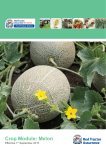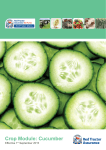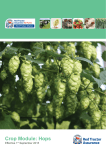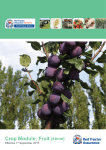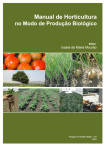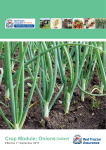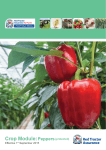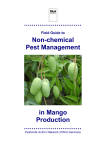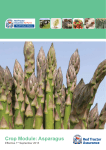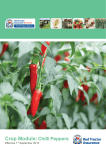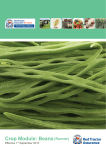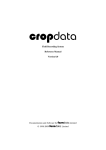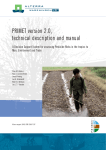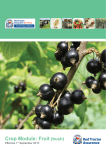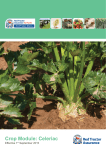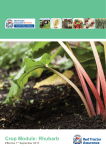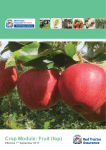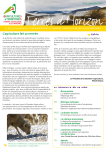Download Crop Module: Aubergines
Transcript
Crop Module: Aubergines Effective 1st September 2015 Welcome T his crop specific module for aubergines has been written to complement and avoid duplicating the generic principles of the Red Tractor Farm Assurance Fresh Produce Scheme standards. It is advisable to read the Red Tractor Farm Assurance Fresh Produce standards before reading this crop specific module. This module is designed to stimulate thought in the mind of the reader. It contains crop specific guidance and standards, where applicable, in addition to the requirements stated in the generic Fresh Produce standards. Within this module the important requirements outlined in the crop specific standards section will be verified during the Red Tractor Farm Assurance assessment and compliance will form a part of the certification/approval decision. Disclaimer and trade mark acknowledgement Although every effort has been made to ensure accuracy, Assured Food Standards does not accept any responsibility for errors and omissions. Trade names are only used in this module where use of that specific product is essential. All such products are annotated® and all trademark rights are hereby acknowledged. General Introduction Following a systematic approach will help growers identify and manage the risks involved in crop production. This module is based on a typical crop production process and food safety, health & safety, environmental and quality hazards are identified. Appropriate controls may then be established to minimise risk. Food safety and health & safety issues always take precedent over quality and environmental controls. The layout of this module follows the same structure as that used in the Red Tractor Farm Assurance Fresh Produce Standards. The content of the module is reviewed prior to the issue of updated editions. The review process considers both new developments and all relevant technology which has emerged since the last review was completed and which have been found to be both workable by the grower and beneficial to the environment. The aim is to transfer such information and technologies to growers. Acknowledgements Red Tractor Farm Assurance Fresh Produce gratefully acknowledges the contribution of all consultees in the preparation of this protocol, particularly Derek Hargreaves. Notes: Pesticide Information The Red Tractor Fresh Produce team has been working with Fera to provide tailored access to the LIAISON database for all Red Tractor Fresh Produce members. This system allows individual growers access to all information for plant protection products approved for use under the Red Tractor Fresh Produce Scheme. LIAISON can be accessed under the Produce tab via the “Checkers and Services” page where you will also find a user manual. Searches will be filtered specifically for the crops for which you are registered. Once you have logged onto the site and clicked on the LIAISON hyperlink you will be directed to the LIAISON home screen. You will need a username and password and these will be sent once you have registered: http://assurance.redtractor.org.uk/rtassurance/ services/Registration/members.eb . 1 Red Tractor Assurance for Farms – Crop-specific Module: Aubergines © Assured Food Standards 2015 Content Contents ADDITIONAL REQUIREMENTS AGAINST CURRENT STANDARDS 02 CROP SPECIFIC STANDARDS02 CHOICE OF VARIETY OR ROOTSTOCK AND PLANT HEALTH CERTIFICATION 04 SITE AND SOIL MANAGEMENT 04 ENVIRONMENTAL PROTECTION AND CONTAMINATION CONTROL05 NUTRITION AND IRRIGATION 10 HYGIENE10 POLLUTION CONTROL AND WASTE MANAGEMENT 11 RESIDUES AND CONTAMINANTS 11 APPENDIX 1: GUIDANCE ON MINIMISING PESTICIDE RESIDUES12 ADDITIONAL REQUIREMENTS AGAINST CURRENT STANDARDS None for this crop module CROP SPECIFIC STANDARDS STANDARDS HOW YOU WILL BE MEASURED CQ.20.a n If two-spotted The previous crop must be cleaned up before its removal from the greenhouse RECORDS (to be kept for 2 years) spider mite and/or broad mite are a problem in this or the previous crop, they are treated before they enter diapause with a high volume spray of abamectin, at least twice at five day intervals n If aphids are present in the old crop pymetrazine is sprayed as necessary before crop removal n WFT is controlled during the life of the crop using biological control so that populations do not present a threat in carry-over Red Tractor Assurance for Farms – Crop-specific Module: Aubergines © Assured Food Standards 2015 2 STANDARDS HOW YOU WILL BE MEASURED CQ.20.b n Disposal At the end of cropping you must remove the crop, weeds and all debris and dispose of them RECORDS (to be kept for 2 years) is achieved either by removing off site (ensuring the load is covered), or burying on site and spraying the soil surface with a disinfectant n Any CQ.20.c Where debris is left in a skip awaiting collection it must be covered with plastic sheeting plastic sheeting that has been used on the floor is rolled up with debris inside and recycled n Cleaning CQ.20.d records Inside the glasshouse, including heating pipes, irrigation lines, drip pegs, hoses, crop wires and other equipment used in the glasshouse, must be washed down and treated with disinfectant (e.g., gluteraldehyde, peroxyacetic acid, benzoic acid etc) n Before CQ.20.e Pest activity in the empty glasshouse must be monitored. Traps must be examined regularly for pests and appropriate action taken if any are caught replanting trap monitoring and treatments are continued in empty glasshouses until no further pests are found monitoring records n Trap CQ.20.f monitoring records Before new plants are placed in glasshouses new traps must be hung and should be assessed and replaced regularly throughout the life of the crop n Weeds CQ.20.g Before replanting and at regular intervals during the season you must destroy all weeds around the glasshouse are destroyed by using non-hormone herbicides of short persistence or by mowing n Use CQ.20.h Disinfectant foot dips must be placed at the entrance to all glasshouses and used by all on entry suitable disinfectant – and ensure foot dips are maintained and used CQ.20.i n Designated There must be designated areas for eating/ drinking/ smoking which are separate to the cropping areas n Cropping areas are clearly signed areas are clearly signed with ‘no eating/ drinking/ smoking’ signs n Records CQ.20.j of the introduction and monitoring of biological control agents The rates of introduction of biological control measures must be based on recommendations of the biological control suppliers n Samples CQ.20.k To assist in the correct calculation of irrigation, volume of run off must be measured and samples analysed for nutrient content to ensure the correct quantity of nutrients are applied of nutrient solution are analysed for nutrient content at least monthly Written procedures must be in place in case of an oil spillage n Records of measurements of run-off n Records of nutrient content of irrigation run-off n Adequate CQ.20.l 3 n Trap procedure to prevent environmental contamination Red Tractor Assurance for Farms – Crop-specific Module: Aubergines n Records of oil spillages © Assured Food Standards 2015 GUIDANCE CHOICE OF VARIETY OR ROOTSTOCK AND PLANT HEALTH CERTIFICATION STANDARD OF PROPAGATED MATERIAL BUYING IN PLANTS Most nurseries now buy plants in from external propagators and it is important to ensure the propagator complies with the requirements set out. Growers should formalise the supply contract with their propagators and agree on the various standards required, stipulating the pesticides that can be used and size of plant at delivery etc. Growers should ensure their propagator adheres to their contractual requirements by requesting records of plant treatment and visiting to inspect plants. It is recommended that for the benefit of both parties, plants should be carefully inspected on delivery and any concerns/ complaints notified immediately to the propagator. Pesticide application records should also be checked to ensure there will be no conflicts with biological control used in cropping. SITE AND SOIL MANAGEMENT SPECIFIC HYGIENE REQUIREMENTS “Old crop” removal The previous crop must be ‘cleaned up’ before its removal from the glasshouse as follows: n If two-spotted spider mite and/or broad mite are a problem, they should be treated before they enter diapause with a high volume spray of abamectin or etoxazol, at least twice at five day intervals. n If aphids are present in the old crop spray with pymetrazine as necessary before crop removal. n It is most important that WFT is controlled during the life of the crop using biological control so that populations do not present a threat in any carry-over. Even now with the reduction in effect of spinosad it is still important to maintain good control using biological control because this product is no longer as effective as it was and there are no new materials coming along to replace it. At the end of cropping, remove the crop, weeds and all debris and dispose of them in a suitable manner removing off site (ensuring the load is adequately covered). Where debris is left in a skip awaiting collection, cover it with plastic sheeting. Where plastic sheeting has been used on the floor, roll it up with debris inside and recycle if possible. Wash down the glass structure inside the glasshouse and then treat with a suitable disinfectant (e.g. gluteraldehyde, peroxyacetic acid, benzoic acid etc). Formaldehyde use is strongly discouraged. Heating pipes, irrigation lines, drip pegs, hoses and other equipment used in the glasshouse should also be treated and crop wires wiped down with a disinfectant. Harvest crates, bins and returnable containers present a problem with contamination and should be thoroughly cleaned between crops and kept clean during the harvesting period to reduce the spread of pests and diseases between production sites and packhouses. Sterilise soil or isolated substrates intended for re-use with steam - unless organic crops are being grown when permission should be sought from your organic standards authority. Monitor pest activity in the empty glasshouse by using yellow sticky traps. Maintaining glasshouses at 17°C will increase the activity of any remaining pests. Examine the traps regularly for pests and take appropriate action if any are caught: Repeat the trap monitoring and treatments in the empty glasshouse before replanting, until no further pests are found. A ring can be drawn round low numbers of pests on sticky traps for monitoring purposes, but if large numbers are present, the traps will have to be replaced after each space treatment. Environment Destroy all weeds around the glasshouse before the new crop arrives and at regular intervals during the season using non-hormone herbicides of short persistence or by mowing. Several common weeds (e.g. chickweed, sowthistle, and dandelion) are known to host cucumber mosaic virus (CMV) and could act as a source of this virus for the crop. Weeds may also be means of carryover of other virus diseases (e.g. TSWV). Dandelions can also carry-over powdery mildew from one crop to the next. They also act as a pollen source for pests such as Western Flower Thrips etc. New crop establishment Before the new plants arrive, old sticky traps should be removed. New traps should then be hung in the glasshouse and should be assessed and replaced regularly throughout the life of the crop. Effective monitoring of these traps is an essential element of pest control. Red Tractor Assurance for Farms – Crop-specific Module: Aubergines © Assured Food Standards 2015 4 The cleanliness and temperature of the vehicles used to transport plants to the production site should be checked to ensure it is adequate - particularly where vehicles have previously been used to transport produce. Trays containing the new season’s plants should be clean. At delivery the pallets should be placed on a clean surface (e.g. new polythene, disinfected and rinsed concrete). For crops grown in rockwool slabs, any previously used slabs should be sterilised with steam and re-used where possible. Place disinfectant foot dips at the entrance to each glasshouse block - and make sure everyone uses them. Keep them inspected and re-filled as needed. E coli and food poisoning Following problems in food in Germany in 2011 it is even more important to ensure there are no risks from food poisoning organisms in your crop. The risks are minimal but both the propagator and the grower should be aware of the risks from contamination with animal manures and contaminated water. See generic protocol for further details. Hygiene Glasshouses must have appropriate “No Smoking/No Food” signs and that staff are provided with a clearly defined area to eat/drink. To avoid problems with crop contamination and also to reduce any risk of plant diseases being brought into cropped areas, no food should be brought into or consumed in any area where crops are being grown. In most circumstances clearly defined areas should be set aside for eating and drinking. These should be clearly signed. Smoking areas, where they are provided, have to be outside by law and must be restricted to non-cropped areas and any designated areas should be clearly signed. Use of bumblebees for pollination of protected salad crops Many of the bumblebees used for pollinating protected salad crops have been of a species which is not native to the UK and can only be supplied and used under a license from Natural England. Native species of bumblebee are also available and these do not carry the restrictions of the non-native species. Growers using non-native bumblebees will be made aware by the suppliers of the requirements necessary to comply with this license and should adhere to these requirements. 5 ENVIRONMENTAL PROTECTION AND CONTAMINATION CONTROL THE BASIC APPROACH TO CROP PROTECTION Integrated Crop Management Key principles of ICM for protected salad crops a. Biological, environmental and cultural methods of pest and disease control must be used as the first line of defence. b. Chemical pesticides are only to be used when biological controls are not available or shown not to be working. c. The crops must be monitored at least weekly and records made of pest, disease and biological control organism levels. d. Records should be kept of introduction and monitoring of biological control agents. e. Climate control computers should be used to ensure a suitable environment is maintained at all times and these systems should be calibrated at least annually to check their accuracy. f. Records must be kept of all pesticide applications. Adaptation for new pests and diseases The occurrence of a new disease or pest problem is largely unpredictable. It may arise, for example, when a previously non-indigenous disease or pest becomes established in the UK (e.g. Southern Green Shield / Stink Bug), with a change in variety or cropping practice (e.g. switch from soil to substrate cropping) or when a pathogen/pest previously controlled by a particular pesticide develops resistance. In all these situations it may be necessary to implement additional pesticide treatments. A proposed schedule for controlling ‘new’ pest or disease problems, in order of priority, is described below. a. A new pest or disease may be subject to statutory action by Fera and this should be established before taking further action. b. The key objective is that the organism is controlled by means of a change in glasshouse environment, crop culture, biological or other non-chemical method. In some situations however, it is possible that additional use of pesticides may be necessary, at least in the short term or until a suitable alternate variety with genetic resistance is available. Such new varieties should be incorporated into the cropping Red Tractor Assurance for Farms – Crop-specific Module: Aubergines © Assured Food Standards 2015 programme, as they become available, providing they meet the end-market specifications. c. The ‘new’ pest or disease situation may be controlled by selecting products already known to be compatible with the biological control measures. d. If none of these pesticides provide effective control, advice should be sought on a suitable alternative product, currently approved for use on the appropriate protected crop under Control of Pesticides Regulations (1986) (As amended 1997) now being replaced by the Biocidal Products Regulations (2001) (As amended) APPROVED USES NOT INCLUDED ON THE PRODUCT LABEL In many circumstances, particularly for minor crops, product labels do not include all of the approved uses and growers wishing to check the approval notice of a particular product should note that this information is available using the LIAISON® search accessible via their RED TRACTOR Farm Assurance home page after logging in. A search on the ‘Extensions of Authorisation for Minor Use’ page of LIAISON® by crop or product name should yield a results page. A click on the product name should link to a summary of the approval information. Near the bottom of the summary is the specific off-label number (e.g. 0246/09) and this link will open up a pdf of the original EAMU document giving details of the extension of use. For various reasons the use of some approved pesticides may not be acceptable to some multiple outlets or processors. In order to conform to such requirements, proposed applications should be confirmed with the contracting company. TRAINING REQUIREMENTS Pest and disease identification Staff working regularly on protected crops should be able to recognise the following pests and diseases: n Powdery n Botrytis mildew (grey mould) on leaves, stems and fruit n Sclerotinia n Pythium n Various n Aphids stem rot root and stem base rot relevant virus diseases n Glasshouse n Bemisia n Leaf whitefly hoppers n Spider mites and other mites n Caterpillar n Leaf whitefly damage miner damage n Thrips n Nezara viridula Southern Green Shield / Stink Bug Staff should know whom to report to when the above pests and diseases, or other problems regularly found on a particular nursery, are first detected during the season. Managers and supervisors should appreciate the relative risk to their crops from the relevant pests and diseases. In service training Training in identification of pests and diseases, their damage and their biological controls and an appreciation of the objectives of this protocol should be given to each new member of staff. All staff working on the nursery, both regular and casual, should be instructed as necessary to satisfy COSHH requirements with respect to pesticide treatments, and to satisfy the requirements of the General Food Hygiene Regulations. Monitoring Regular monitoring of the biological control agents, pests and diseases is of vital importance. It is essential that all crops are walked at least once a week and records kept of each inspection. All nursery staff should be alert to fresh pest or disease symptoms or signs of imbalance with biological control mechanisms. PEST CONTROL Ensure all picking boxes, bins, trolleys, tractor tyres, footwear and any associated tools and equipment are kept thoroughly clean. Treat routinely with an appropriate disinfectant and routinely wash clothing and gloves. Store cleaned boxes and equipment carefully to avoid re-contamination. After using disinfectants in the glasshouse thoroughly ventilate the house to remove all traces of vapour. Rinse picking trays with water after treating with the disinfectant to remove any residues before use. Red Tractor Assurance for Farms – Crop-specific Module: Aubergines © Assured Food Standards 2015 6 Biological control organisms (BCOs) The table below lists currently available biological control measures. The rates of introduction should be based on recommendations of the biological control suppliers. Introduction and monitoring of biological control agents must be recorded. PEST CONTROL NOTES Glasshouse whitefly (Trialeurodes vaporariorum) a)Encarsia formosa e)for corrective action. Needs high humidity to establish b)Eretmocerus californicus c) Macrolophus caliginosus d)Beauveria bassiana (Naturalis-L®) e)Verticillium lecanii (Mycotal®) f)glucose polymer (Eradicote® Majestik®) g)sticky traps Sweet potato whitefly (Bemisia tabaci) Statutory quarantine pest in UK. Inform PHSI. Serious virus vector Biological control may be allowed Spider mites (Tetranychus urticae) (Tetranychus cinnabarinus) a)Phytoseiulus persimilis e)also has activity against other pests such as aphids b)Amblyseuis californicus c) Feltiella acarigusa d)Beauveria bassiana (Naturalis-L®) e)glucose polymer (Eradicote® Majestik ®) Caterpillar - various species a)Hand picking c)only effective on early larval stages b)Pheromone traps d)egg parasite only. Use not permitted in Guernsey c) Bacillus thuringiensis d)Trichogramma evanescens Caterpillar - Tuta absoluta, Spodoptera spp and Heliothis spp Statutory quarantine pests in UK. Inform Fera Biological control may be allowed Macrolophus is a useful egg predator Tomato leaf miner (Liriomyza bryoniae) a)Leaf removal plus b) and c) b)Dacnusa sibirica Macrolophus is active against leafminer c) Diglyphus isaea American serpentine and South American leaf miners (Liriomyza trifolii and L. huidobrensis) Statutory quarantine pests in UK. Inform PHSI Glasshouse leaf hopper (Hauptidia maroccana) Action not required at present levels but may be needed in future. Macrolophus is active against leaf hoppers Aphids (various species) a)Aphidius colemani Biological control may be allowed Can be serious as numbers build up very rapidly. b)Aphidius ervi c) Beauveria bassiana (Naturalis-L®) d)Verticillium lecanii (Vertalec ) ® e)should be directed onto aphids e)glucose polymer (Eradicote®, Majestik®) Western flower thrips a)Amblyseius cucumeris b)Orius spp. (Frankliniella occidentalis) Onion thrips (Thrips tabaci) a),b) & c) establish well on aubergine c) Macrolophus caliginosus d)Beauveria bassiana (Naturalis-L®) e)Verticillium lecanii (Vertalec®) f) glucose polymer (Eradicote®, Majestik®) Other thrips (various species that will need identification) 7 Leaflet removal Red Tractor Assurance for Farms – Crop-specific Module: Aubergines Monitor closely and seek advice if numbers increase © Assured Food Standards 2015 Chemical control Biological controls are not available for some pests and suitable pesticides are recommended. PEST ACTIVE INGREDIENT NOTES Whitefly a)dodecylphenol ethoxylate (Agri 50 E ®) Double Encarsia introduction for two weeks after any whitefly spray treatment b)spiromesifen b)can be damaging to Phytoseiulus c) fatty acids d)thiacloprid damages biological control and use should be restricted to spot treatments and clean up. Although thiacloprid is still approved it is felt that its use should be restricted during the moratorium on field use d)thiacloprid Spider mites a)spiromesifen All can be damaging to Phytoseiulus b)abamectin c)etoxazol Aphids ( A. gossypii) a)pymetrozene b)glucose polymer (Eradicote®, Majestik®) c)thiacloprid Other aphid species a)pirimicarb b)pymetrozine Western flower thrips a)spinosad b)glucose polymer (Eradicote®, Majestik®) Caterpillars a)Hand picking b)Bacillus thuringiensis c)indoxacarb Use products with a different mode of action to avoid resistance c)thiacloprid damages biological control and use should be restricted to spot treatments and clean up. Although thiacloprid is still approved it is felt that its use should be restricted during the moratorium on field use Limited data shows pymetrozine is reasonably safe on biological control agents a)early treatment is needed to prevent damage to fruits. Biological control has to be the first line of control as spinosad is no longer very effective a)effective if numbers or plants affected are low b)should be applied when larvae are small d)deltamethrin d)only be used as a last resort and at the end of the season Southern Green Shield / Stink Bug a) hand picking Nezera viridula b) lambda-cyhalothrin b)very damaging to biological control – last resort action Not all formulations of each active ingredient may be currently approved for use on aubergines. Check before use. Label recommendations are revised regularly, read the current label before use. Red Tractor Assurance for Farms – Crop-specific Module: Aubergines © Assured Food Standards 2015 8 DISEASE CONTROL Certain diseases are relatively common and occur on many holdings each year. The procedure for the control of the common disease problems is given in detail. The procedure for other diseases is given in outline and further technical advice should be sought as necessary. It cannot be emphasised too strongly that regular crop monitoring with rapid and accurate disease identification and an appropriate rapid response, involving cultural changes, a glasshouse environmental change, rouging of the affected plant or a fungicide treatment, is essential to fulfil the objective of minimising fungicide use. All crops should be walked and inspected for disease at least once every seven days. If disease is overlooked, or seen but no action taken, then several fungicide applications may be required to bring the problem under control, compared with perhaps one or two applications if prompt action is taken. Botrytis Preventative action decision Fungicides General Control humidity (<85% RH) Keep foliage and floor dry Avoid plant damage Remove debris after crop work On young plants Avoid damage at planting Treat if damaged Cyprodinil + fludioxonil, iprodione On flowers, leaves, branches and fruit Check humidity control and plant handling Cyprodinil + fludioxonil, iprodione Treat with fungicide as soon as disease occurs Alternate chemical groups to reduce risk of resistance Notes: (1) maximum of five applications of iprodione per crop. Resistance to fungicides is becoming increasingly common. Reduced disease control will occur where resistant isolates are present. White rot (Sclerotinia) Preventative action decision Fungicides General Mainly on soil grown crops but can affect substrate crops in poor conditions. Control humidity (<85% RH) Keep foliage and floor dry - cover soil with plastic sheeting Fungicides used for Botrytis control will give some protection against Sclerotinia Avoid plant damage Remove debris after crop work Remove and burn affected parts On young plants Avoid damage at planting Remove and burn affected parts On flowers, leaves, branches and fruit Check humidity control 9 Red Tractor Assurance for Farms – Crop-specific Module: Aubergines © Assured Food Standards 2015 OTHER DISEASES Disease Comment Action Pythium root rot Young plants are more susceptible Use clean water source. Sterilise soil and re-used slabs. Drench with fosetyl aluminium + propamocarb hydrochloride Phytophthora root rot Uncommon but could be a problem on tomato rootstocks Use clean water source. Sterilise soil and re-used slabs. Avoid water logging Rhizoctonia stem base rot Uncommon. Soil crops Sterilise soil. Spray with cyprodinil + fludioxonil Powdery mildew Frequently seen but does not usually cause problems Spray sulphur (1) if severe Verticillium wilt Rare. Mainly soil crops Sterilise soil use resistant rootstock Notes: Re-used rockwool slabs should be sterilised with steam. Not all formulations of each active ingredient may be currently approved for use on aubergines. Check before use. Label recommendations are revised regularly, read a current label before use. NUTRITION AND IRRIGATION HYGIENE Steps should be taken to minimise nitrate levels in applied nutrient solutions. It is strongly recommended that water and nutrients are re-circulated. If not, steps should be taken to minimise nutrient run-off into soil and water courses. Because of proposed changes in legislation, growers are advised to investigate re-circulation. Anyone dealing with food is affected by the Food Hygiene Regulations. This includes workers harvesting in glasshouses as well as those on graders and in halving and pre-packing departments. The volume of run-off should be measured and samples analysed. Most production areas are now in Nitrate Vulnerable Zones (NVZ) following the changes in designation growers should be aware of the requirements of any legislation governing use of fertiliser on their nursery. Where possible, water and nutrients should be recirculated to conserve water and also reduce any possible run-off of nutrients. To assist in the correct calculation of irrigation, volume of run off should be measured and samples analysed for nutrient content to ensure the correct quantity of nutrients are applied. Irrigation requirement should be closely matched to crop need and steps should be taken to minimise nutrient run off - particularly nitrate and phosphate - into soil and water courses. As with most legislation, most of the actions you have to follow are common sense. Cleanliness is part of the job. You must not deliberately contaminate the produce. You must not place produce where there is any risk of contamination. Picking boxes and bins are for produce only. Keep them clean! Personal washing facilities (basin, soap, etc) are for personal cleanliness only. Use them frequently. In light of the problems caused by the E coli outbreak in Northern Germany in 2011 it is particularly important that produce is kept clear of any contamination and that you can demonstrate that your produce is free from contamination. Sample supply water and diluted feeds for bacterial contamination regularly. Glasshouses and pack houses must have appropriate “No Smoking/No Food” signs and that staff are provided with a clearly defined area to eat/drink. Smoking areas may need to be designated and a shelter provided. Red Tractor Assurance for Farms – Crop-specific Module: Aubergines © Assured Food Standards 2015 10 POLLUTION CONTROL AND WASTE MANAGEMENT There must be written procedures for the management and recording of incidents involving oil spillages. RESIDUES AND CONTAMINANTS PESTICIDE RESIDUES IN FRESH PRODUCE Red Tractor Farm Assurance Fresh Produce is aware that a key area in the production of fresh produce which requires continued attention by growers and their advisers is that of keeping pesticide residues to a minimum. This issue is not just one of meeting the MRL trading standard but ensuring that any individual or multi residues are kept as low as possible below this level. The key targets are: n Optimising earliest applications of fungicides and insecticides to the edible part of the crop to reduce residue at time of harvest. n Ensuring minimum harvest intervals are followed n Ensuring that application equipment is regularly cleaned and is applying products correctly and evenly n Ensuring all those involved in applying pesticide products are adequately trained and qualified See Appendix for the pesticide targets and guidelines on this crop. 11 Red Tractor Assurance for Farms – Crop-specific Module: Aubergines © Assured Food Standards 2015 APPENDIX 1: GUIDELINES ON MINIMISING PESTICIDE RESIDUES These guidelines have been produced after consultation between crop stakeholders and the Fresh Produce crop author. They will be developed over the coming seasons as knowledge on minimising residues develops. Growers should consult with their crop protection adviser to ensure other best practices are not compromised before considering these guidelines. There have been problems in the past with the active ingredients listed below that may give rise to crop residues and growers should be aware of the potential problems and work out alternative strategies. Active Ingredient Target: pest, weed, disease Current position Suggested guidelines chlormequat Not approved for use in the UK Found in imported produce and once in UK labelled produce (assumed to be imported) Ensure all imported produce is correctly labelled. Do not use on UK produce cyprodinil + fludioxonil Botrytis Residue found occasionally just below the limit of determination but well below MRL Use alternatives where available. Use at lowest effective rate imidacloprid Not approved for use in the UK Found in imported produce and once in UK labelled produce (assumed to be imported) Ensure all imported produce is correctly labelled. Do not use on UK produce pymetrozine Aphids and whitefly Not normally detected in PRC samples but occurring in grower samples Do not use frequently in the crop and aim to control whitefly biologically tebuconazole Not approved for use in the UK Found in imported produce and once in UK labelled produce (assumed to be imported) Ensure all imported produce is correctly labelled. Do not use on UK produce No other active ingredients causing residue problems a. Pesticide use on UK aubergines is low b. There are no organochlorine or organophosphates insecticides approved for use on UK aubergine crops nor any herbicides, plant growth regulators or post-harvest treatments. c. There have been a small number of un-approved residues found in UK product in the recent past that indicate possible import substitution rather than illegal pesticide use – both activities give a poor image of UK aubergine production. d. Integrated Crop Management strategies for pest and disease control should continue to be the key approach to be used, with emphasis on nonpesticide strategies. e. Virtually all UK commercial aubergine crops are grown in heated glasshouses. This affords the opportunity for effective deployment of biological pest control and the prevention of disease infection by environmental manipulation. f. Those pests and diseases for which pesticide intervention is still most likely to be required in the UK are aphids, WFT, spider mites, whitefly, Nezara, Botrytis and Sclerotinia. Powdery mildew is occasionally a problem but pesticide intervention is hardly ever worthwhile. The acceptance of materials for pest and disease control through a physical mode of action as not being pesticides, and therefore not having to comply with pesticide legislation or having residue problems, should be considered. Examples are plant extracts of garlic1, glucose polymers2, polysaccharides3 and fennel4 e.g. Garshield1, Ecospray1, Eradicoat2, Majestik2, Agri-50E3 and Fenicur4 respectively. Recently Eradicote and Majestik have been registered as pesticides but the “active” ingredient has not changed and is still a physical mode and leaves no pesticide residue. Red Tractor Assurance for Farms – Crop-specific Module: Aubergines © Assured Food Standards 2015 12 Recommendations for minimising residues Crop specific recommendations for aubergines Generic recommendations Most sprays leave unacceptable residues on the fruit. In most circumstances – especially when considering control of mildew – it may be worth avoiding pesticide spraying altogether. Avoid pesticide use by: n good husbandry, including irrigation and nutrition to maintain healthy plants. n good site hygiene – including good weed control outside the glasshouse. nuse of clean plant material. n use of biological control agents for pest control, and when available, disease control. nuse of environmental manipulation. Aim to extend the harvest interval beyond that recommended to reduce any chance of residue being present in the produce. Import substitution seems to be an issue – even if it is only small - when looking at residues found on UK labelled product. This is illegal and does nothing but harm the reputation of UK product – don’t do it! nuse Full details of approved pesticides EAMUs (Extension of Authorisation for Minor Use) for use on cucumber are available on the LIAISON® and CRD websites – details as follows: Minimise pesticide use by: Liaison website – www.fera.defra.gov.uk Maintaining strict routines of crop monitoring to ensure that any remedial action is taken at the first opportunity for greatest effect with least sprays. CRD website – www.pesticides.gov.uk/pestreg of spray materials with physical modes of action (non-pesticides) where appropriate. Ensuring adequate training in the recognition of pests, diseases and biological control agents by all staff, especially crop workers, to ensure rapid and appropriate response. Ensuring adequate training in glasshouse environment control, for disease suppression especially. Maintaining, cleaning and calibrating boom sprayers with care to ensure efficient spray application. Ensuring correct dose rate as this may vary according to the target pest and whether on or off label. Choosing any pesticides with careful attention to possible side effects on biological control agents. 13 Red Tractor Assurance for Farms – Crop-specific Module: Aubergines © Assured Food Standards 2015 Certification Bodies Your routine point of contact with the Scheme is through your Certification Body. Certification Bodies are licensed by Red Tractor to manage membership applications and to carry out assessment and certification against the Standards. The table below shows which Certification Bodies apply to each enterprise. Certification Body NSF Kiwa PAI SAI Global SFQC Beef and Lamb Dairy Combinable Crops and Sugar Beet Fresh Produce 4 4 4 4 4 4 4 4 4 4 4 4 4 4 4 4 NIFCC (Northern Ireland) 4 QWFC (Wales) 4 Pigs Poultry 4 4 4 4 4 4 4 NSF Certification Kiwa PAI Hanborough Business Park Long Hanborough Oxford OX29 8SJ Tel: 01993 885739 Email: [email protected] Web: www.nsf-foodeurope.com The Inspire, Hornbeam Square West, Harrogate, North Yorkshire HG2 8PA Tel: 01423 878878 Email: [email protected] Web: www.kiwa.co.uk/pai SAI Global Assurance Services Ltd PO Box 6236, Milton Keynes MK1 9ES Tel: 01908 249973 Email: [email protected] Web: www.saiglobal.com/assurance QWFC SFQC Ltd NIFCC [Northern Ireland] QWFC [Wales] Royal Highland Centre, 10th Avenue, Ingliston, Edinburgh EH28 8NF Tel: 0131 335 6605 Email: [email protected] Web: www.sfqc.co.uk Lissue House, 31 Ballinderry Rd, Lisburn, Northern Ireland BT28 2SL Tel: 028 9263 3017 Email: [email protected] Web: www.nifcc.co.uk PO Box 8, Gorseland, North Road Aberystwyth SY23 2WB Tel: 01970 636688 Email: [email protected] Web: www.wlbp.co.uk T: 01932 589 800 E: [email protected] www.redtractorassurance.org.uk Fresh Produce Standards
















